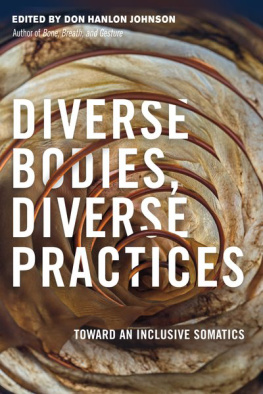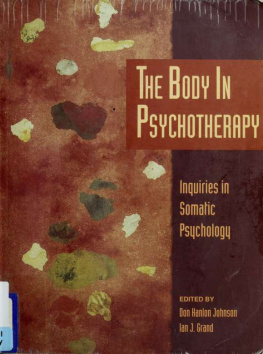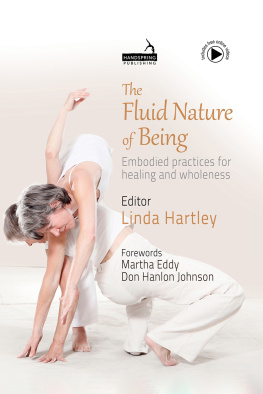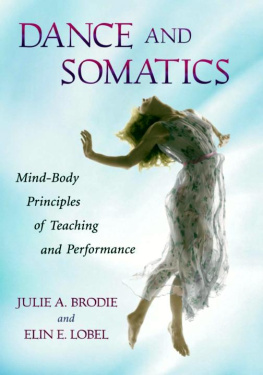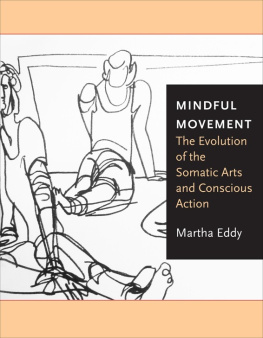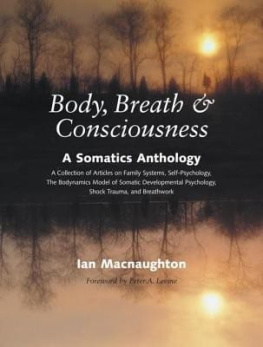
Copyright 2018 by Don Hanlon Johnson. All rights reserved. No portion of this book, except for brief review, may be reproduced, stored in a retrieval system, or transmitted in any form or by any meanselectronic, mechanical, photocopying, recording, or otherwisewithout the written permission of the publisher. For information contact North Atlantic Books.
Published by
North Atlantic Books
Berkeley, California
Cover photo 2018 by Rosalyn Driscoll
Cover design by Rob Johnson
Book design by Happenstance Type-O-Rama
Photos of Stephanie Francis-Ecoffey, Don Hanlon Johnson, Roger Kuhn, Jules Pashall, Antoinette Santos Reyes, Kurt Wagner, Nick Walker, Alyssa N. Zelaya, and group photo of authors by Rockwell Creative
Photo of tayla ealom by Michael Wellman
Photo of Haruhiko Murakawa by Ako Murakawa
Printed in the United States of America
Diverse Bodies, Diverse Practices: Toward an Inclusive Somatics is sponsored and published by the Society for the Study of Native Arts and Sciences (dba North Atlantic Books), an educational nonprofit based in Berkeley, California, that collaborates with partners to develop cross-cultural perspectives, nurture holistic views of art, science, the humanities, and healing, and seed personal and global transformation by publishing work on the relationship of body, spirit, and nature.
North Atlantic Books publications are available through most bookstores. For further information, visit our website at www.northatlanticbooks.com or call 800-733-3000.
Library of Congress Cataloging-in-Publication Data
Names: Johnson, Don Hanlon, 1934- editor.
Title: Diverse bodies, diverse practices : toward an inclusive somatics /
edited by Don Hanlon Johnson.
Description: Berkeley, California : North Atlantic Books, [2018] | Includes
bibliographical references and index.
Identifiers: LCCN 2018015024 (print) | LCCN 2018019036 (ebook) | ISBN
9781623172893 (e-book) | ISBN 9781623172886 (pbk.)
Subjects: LCSH: Mind and body. | Mind and body therapies.
Classification: LCC BF161 (ebook) | LCC BF161 .D58 2018 (print) | DDC
616.89/1dc23
LC record available at https://lccn.loc.gov/2018015024
North Atlantic Books is committed to the protection of our environment.
We partner with FSC-certified printers using soy-based inks
and print on recycled paper whenever possible.
Acknowledgments
To Rosalyn Driscoll for her generous contribution of her sculpture for the cover design, and also for the many contributions to cover art that she has made in the past to the volumes in this series of somatic texts edited by North Atlantic Books.
To Scott Hoag for his offer of many of the photos in this book.
To the many people at North Atlantic Books, especially Richard Grossinger and Lindy Hough, who have supported our somatics communitys body of literature for nearly twenty-five years.
Introduction
Borderlands
Don Hanlon Johnson
1. From Division to Creation
For my colleagues and myself, the juice in crafting this volume comes from the joy that arises from joining with an Other to create something new. The great cellist Yo-Yo Ma inspired both my conception of this project and helped me appreciate the deep joys and illuminations that I received in the process of following it through with this idiosyncratic, intricately thoughtful, and wildly creative group of people who are so different, one from another. At the end of the last century, Yo-Yo Ma created The Silk Road Ensemble, gathering musicians, singers, and songwriters from the entire length of the first Silk Road, which crossed the Eurasian landmass from Kamchatka to Prague. He took on the project when he was struck by finding that all along that endless route, musicians had for centuries relished playing with one another, even though their instruments and words were strange to each otherand while the religious and secular leaders along those same paths were engaging in endless bloody conflicts, which they continue to this very day. In fact, the words even though do not do justice to the significance of his insight. What he grasped, thanks to these various artists, is that in the case of creativity and the imagination, difference is an essential component, moving the creative person out of the already-done into the fresh world of the not-yet-explored.
Over the past fifteen years, I have attended many of the gatherings of these musicians, where you can witness a living model of a creative community of radically different people, where the differences are transformed from problems into stimuli for a soul-wakening freshness. What makes their work possible in a world riven by conflict is that they are operating on the subconceptual, nonideological level, where the sensations of rhythm, movement, sound, and words felt in the throat and mouth take precedence over the ethereal philosophies and theologies that are used (or misused) to support violent struggles for wealth and power. In doing so, these artists penetrate to the heart of those deeper impulses and longing to create a more humane and just world. In their emphasis on the nonconceptual realm, their work is not so different from ours, which is based in silent touch, moving, sensing, and sounding. As I worked with each of the gifted authors in this book, I kept finding myself in that joy that comes from working with others to create something genuinely fresh: the unexpected insights and formulations, the move toward new layers of understanding how our lives together might be more satisfying. A clear hope emerges that perhaps we might make some contribution to efforts to turn diversity from a source of strife into a nudge toward creating the new.
In crafting this work, one question that has motivated us is: How do we create a community that not only tolerates the inevitable crossings of so-called secure borders, but welcomes the ever-fluctuating tides of peoples moving here and there, while feeling the enormous creative possibilities of joining with those with radically different perspectives to create a more intricate and interesting social order? The seemingly simple solutions to the tensions that arise in the encounters with the margins, like the old great walls of Hadrian and Genghis Khan, and the anachronistic walls now abuilding in various tension points around the world, are clung to in the old fears of the Other, with little lasting success. In the chapters that follow, you will find people building their strategies of creating a more just and satisfying world by openly sharing intimate details of the suffering that they have endured and shaped into capacious adult selves, creating an atmosphere of recognition for the struggles we all make to become human. An honoring of each trail of tears has the potential to transform our fears of the Other into compassion for one like ourselves, helping create an effective community of resistance and transformation.
2. Shared Suffering
An unanticipated common theme emerged as we worked together: that we each arrived at this particular conjunction of people and task from histories of intense strugglephysical and emotional. In writing together about the different textures and colors of that struggle, we found ourselves closer in our shared creativity and more effective in succeeding at the difficult task of this production. It shouldnt have surprised me, knowing that grief is a turning point in the process of healing. And yet, because we each are so different, one from another, in so many categoriesgender identification, color, age, dysfunctions, neural capacities, religious backgrounds, and current ideologiesthis closeness came as a surprise.
Next page
